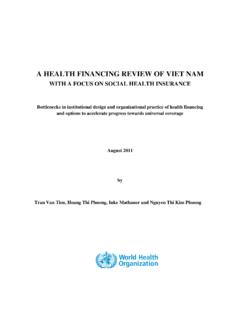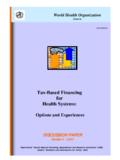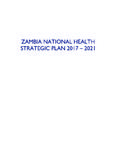Transcription of Options for Developing Financing Instruments …
1 Financing renewable energyOptions for Developing Financing Instruments Using Public Fundsin collaboration with African Development Bank, Asian Development Bank, European Bank for Reconstruction & Development, Inter-American Development Bank, International Finance CorporationiiiCONTENTSC ontentsAcknowledgments ..vPreface ..viiIntroduction ..ixOBJECTIVE ..ixAPPROACH ..ixOVERVIEW ..ix1 Why the Choice of Financial Instruments Matters ..12 Identifying the Risks and Barriers .. OVERVIEW .. Financing BARRIERS .. RISKS OF RET PROJECTS .. THE SIGNIFICANCE OF TECHNOLOGY ..93 Financial Instruments .. OVERVIEW .. GRANTS AND LONG-TERM EQUITY.
2 VENTURE CAPITAL EQUITY .. DEBT .. ASSET-BACKED SECURITIES .. GUARANTEES AND INSURANCE .. RESULTS-BASED Financing .. CARBON Financing .. SMALL-SCALE PROJECT Financing ..254 The Role of Financial Intermediaries .. COMMERCIAL FINANCIAL INSTITUTIONS .. FUNDS AND OTHER SPECIALIZED INTERMEDIARIES ..315 Selecting the Appropriate Financing Instruments ..336 Making it Work .. INSTITUTIONAL CAPACITY .. POLICY AND PLANNING FRAMEWORK .. SUPPORT MECHANISMS ..367 References and Further Reading ..39 Appendix 1 List of Initial Case Studies ..40 Financing RENEWABLE ENERGYiv Appendix 2 Summary of Financial Instruments .
3 41 Appendix 3 Summary of Financial Intermediaries ..47 Appendix 4 Financing Instruments Appropriate for Addressing Financing Barriers and Project Risks ..48vACKNOWLEDGMENTSFINANCING RENEWABLE ENERGYA cknowledgmentsThe following paper and accompanying Web tool were developed by a World Bank team (made up of members of the Sustainable Development Network Financial Solutions and Energy teams). The team was led by Mustafa Zakir Hussain. Gevorg Sargsyan provided important inputs at all stages. Teuta Kacaniku and Ashaya Basnyat were core members of the team, and William Derbyshire of Economic Consulting Associates provided significant substance and drafting inputs to the paper.
4 Federico Q erio worked extensively on Developing the accompanying Web paper and accompanying Web tool have benefited from World Bank review. Peer review-ers included: Mikul Bhatia (SASDE), Jeremy Levin (IFC), and Varadarajan Atur (AFTEG). Additional comments were received from Richard Hosier (ENVGC), Magnus Gehringer (ESMAP), Gabriela Elizondo Azuela (SEGEN), and Kenneth Chomitz (IEG).This work benefitted from support provided by the Climate Investment Funds (CIFs), through its Scaling Up Renewable Energy Program (SREP) in Low-Income Countries. It has also received comments and inputs from the other multilateral development banks working with the CIFs: African Development Bank (AfDB), Asian Development Bank (ADB), European Bank for Reconstruction and Development (EBRD), the Inter-American Development Bank (IDB), and the International Finance Corporation (IFC).
5 In particular, Gregorz Peszko (EBRD), Claudio Alatorre Frenk (IDB), and Wesly Ure a-Vargas (IDB) are to be thanked. A draft version of this paper and Web tool was presented to borrower and donor government delegations during the annual CIFs meetings held in Cape Town in June 2011. Financing RENEWABLE ENERGY viviiPREFACEFINANCING RENEWABLE ENERGYP refaceTo create new economic opportunities, increase energy access, and reduce carbon emissions, the governments of many low-income countries have embarked on the path to low-carbon develop-ment. But because funding from public and concessional sources is scarce, an engaged private sec-tor will be needed to make significant investments in renewable energy technologies (RETs).
6 With an appropriate enabling framework, those investments should be forthcoming. The development of appropriate Financing Instruments using public and concessional resources such as those provided under the Scaling-up Renewable Energy Program (SREP) is one way to address the barriers and risks that presently hold back private investment. Using public and concessional funds to mobilize private Financing rather than to pay the underlying costs of RETS offers the twin advantages of being more sustainable and minimizing the possibility of crowding out the private paper offers a framework for analyzing the types of Financing Instruments that are most appropriate for addressing prevalent barriers and risks.
7 This is seen as particularly relevant in the context of international climate finance discussions. The experience to date has been that policy makers tend to go straight to the use of a particular Financing instrument without necessarily ana-lyzing which instrument would be most effective for a given set of conditions. The paper and the accompanying Web tool (known as REFINe and available at ) will provide information in a structured manner to allow policy makers to make fully informed decisions. Both the paper and the accompanying Web tool are designed for easy use. They focus on practi-cality and usability, rather than comprehensiveness, and are intended to be used more broadly than under the SREP alone.
8 Associated case studies and reference lists will be updated and developed over time in the online selecting Instruments , efficiency is key. Policy makers should aim to use Instruments that deliver the greatest amount of private Financing for the least amount of public funds (thus achiev-ing maximum leverage). To do so, Financing Instruments need to be appropriate for addressing the specific barriers and risks specific to the RETs being RETs have different degrees of exposure to the various identified barriers and risks. Barriers are created by underdeveloped financial markets. Examples of barriers include lack of long-term loans, high Financing costs, high transaction costs, and poorly capitalized refer to the high risks and costs of RETs.
9 They include cost competitiveness, technology risks, regulatory risks specific to making RETs competitive, and resource risks. The paper considers how well different Financing Instruments address different barriers and risks. The list of Instruments covered includes grants, equity, debt, asset-backed classes, guarantees, and insurance as well as more targeted categories such as results-based Financing , carbon Financing , and small-scale project Financing . Delivery mechanisms such as commercial financial intermediaries and funds are consid-ered on the relationship between Instruments and barriers/risks consists of 33 case studies, most provided by the World Bank, International Finance Corporation, African Development Bank, Asian Development Bank, European Bank for Reconstruction and Development, and the Inter-American Development Bank.
10 Other case studies are expected to be added to the REFINe Web site over time to provide a growing and continually updated reference source. It is important to remember that there is no simple link between barriers/risks and the appro-priate Financing Instruments . More than one instrument could be suitable to address each barrier/risk, or a single instrument could address multiple barriers/risks. This paper and the Web tool use Financing RENEWABLE ENERGY viiithe case studies to suggest which types of Instruments may be most appropriate for addressing par-ticular barriers and risks, with the aim of attracting significant additional investment.













